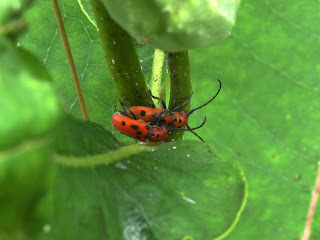Red Milkweed Beetles
Here is a Red Milkweed Beetle couple I met while they were in the throes of passion. These are fairly commonly found on milkweeds, especially the Common Milkweed. Though not particularly large, their red bodies with black spots and long black antenna makes them stand out pretty well on the mostly-green milkweed plants they're usually found on.
The red is considered aposematic coloring in that it warns would-be predators that these beetles are at least bad tasting and potentially poisonous. It achieves this despite limiting it's exposure to the milky latex substance in milkweeds. They will bite through a leaf's vein first, impeding the flow of the latex "down vein" of the leaf, and then they'll do their eating down there where they don't encounter a lot of the latex. (Apparently the latex could harden over their mouths, so if they get latex on themselves they quickly try and scrape it off.)
Although females are considered to be slightly larger, the males and females are pretty similar; I'd consider these beetles to be sexually monomorphic. It sounds like these beetles don't find each other by pheromones; the males and females simply hook up by hanging around milkweed plants that function as singles bars for them.
Though I've never heard them, apparently they can purr and squeak, with the purring more often a contented noise and the squeak used more during some degree of alarm/alertness.
Although I wouldn't consider them to be the most adroit fliers in the insect world, they have been known to fly away from photographers. Some tech savvy NJ high schoolers used them to design small flying robots.
 |
| July 13, 2021 at Washington Valley Park Photo 148186503, (c) jpviolette, some rights reserved (CC BY-NC) |



Comments
Post a Comment